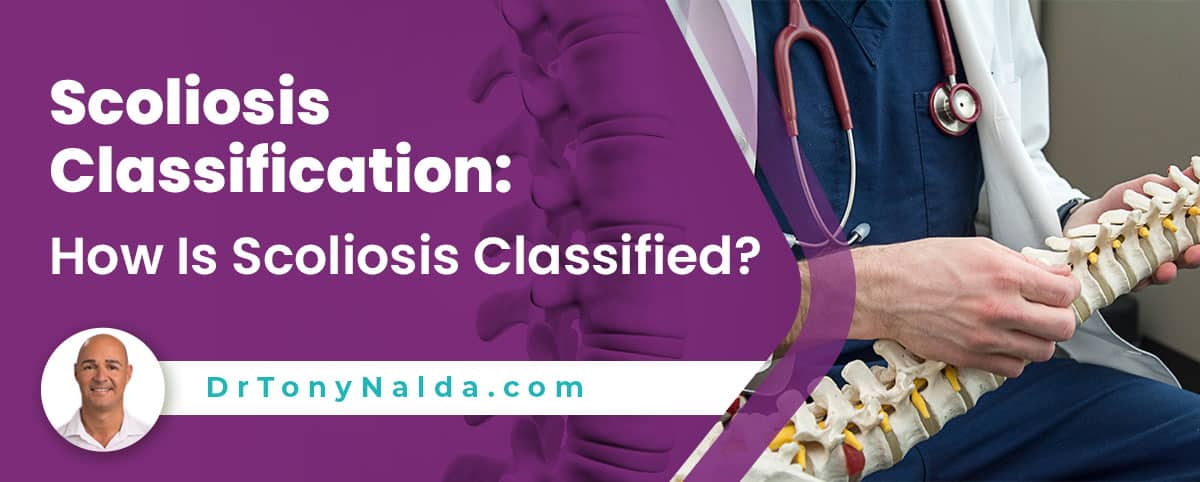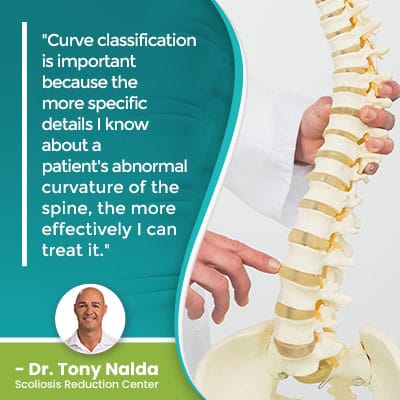Scoliosis Classification: How Is Scoliosis Classified?

Scoliosis is a complex condition to treat because no two cases are the same, which is why the customization of effective treatment plans is necessary. The scoliosis classification system helps streamline the treatment process. Continue reading to learn how scoliosis is diagnosed and classified.
Part of diagnosing scoliosis involves comprehensively assessing conditions so they can be further classified based on key patient/condition variables: patient age, condition severity, condition type, and curvature location. The classification-points are what treatment plans are shaped around.
As classifying scoliosis is part of the diagnostic process, let's start with the parameters that have to be met in order to reach a diagnosis of scoliosis.
Table of Contents
How is Scoliosis Diagnosed?
According to current Scoliosis Research Society estimates, there are close to seven million people currently living with scoliosis in the United States alone, and as the leading spinal condition amongst school-aged children, scoliosis awareness is important.
There are a number of spinal disorders that involve a loss of its healthy curves, but scoliosis has some additional characteristics that set it apart.
Scoliosis involves the development of an unnatural sideways structural curve in the spine, and a scoliotic curve also has to have an element of rotation to be considered a true scoliosis.
In addition, a scoliotic spinal deformity has to be of a minimum size: Cobb angle measurement of at least 10 degrees.
A diagnosis is reached through a comprehensive physical examination that involves taking a patient's medical history, with a focus on any spinal conditions within the family, performing an Adam's forward bend test, as this puts the spine in a highly-visible position, and ordering an X-ray and/or magnetic resonance imaging to really see what's happening in and around the spine, and to confirm a diagnosis of scoliosis by determining the patient's Cobb angle.
So if these parameters are in place, a diagnosis of scoliosis is given, but a patient isn't just told, "You have scoliosis." There are a number of classification-points that are included in a diagnosis, and for the average person, they can be confusing, so let's explore each point and why it's important.
The Scoliosis Classification System
As mentioned, classifying scoliosis helps streamline the treatment process across different treatment providers, and it also provides the information needed to craft effective and customized treatment plans.
 Scoliosis is classified based on patient age, condition severity, condition type, and curvature location; each variable is important because it indicates certain condition characteristics like experienced symptoms, progressive rates, and the areas of the body most likely to be affected.
Scoliosis is classified based on patient age, condition severity, condition type, and curvature location; each variable is important because it indicates certain condition characteristics like experienced symptoms, progressive rates, and the areas of the body most likely to be affected.
Patient Age
Patient age is important, not only because it can indicate a person's overall level of health and fitness, it also helps me predict a patient's likeliest progressive rate.
Scoliosis is a progressive condition, meaning its very nature is to get worse over time, and while we don't always know what triggers its initial onset, we do know what triggers it to progress: growth and development.
So in patients who are still growing, I know rapid progression is a risk, but in adults who have reached skeletal maturity, I know the constant trigger of growth is removed, so can focus treatment differently.
In addition to a patient's progressive rate, patient age is also an important predictor of experienced symptoms.
In patients who are still growing, the constant lengthening motion of a growing spine counteracts the compressive force of the unnatural spinal curve, but in adults, compression of the spine and its surrounding muscles and nerves can cause a lot of pain, and pain is the number-one symptom of adult scoliosis.
The reality is that scoliosis affects all ages from congenital scoliosis to infantile scoliosis, early-onset juvenile scoliosis, adolescent scoliosis, and adult scoliosis.
So patient age can indicate a patient's likeliest progressive rate, along with whether or not pain management is likely to be needed as a focus of treatment.
Condition Severity
Condition severity is a key factor that tells me how far out of alignment a scoliotic spine is; the further out of alignment the spine's vertebrae are, the more severe the condition, the larger the unnatural spinal curve is, and the more noticeable the condition's effects are likely to be.
Condition severity is determined during X-ray by a measurement known as Cobb angle.
The Cobb method is known as the gold standard in the assessment of scoliosis and involves drawing lines from the tops and bottoms of the curve's most-tilted vertebrae, at its apex, and the intersecting angle is expressed in degrees.
The condition's severity levels are also its progressive line, so where a scoliosis is at the time of initial diagnosis isn't indicative of where it will stay, especially if left untreated.
- Mild scoliosis: Cobb angle measurement of between 10 and 25 degrees
- Moderate scoliosis: Cobb angle measurement of between 25 and 40 degrees
- Severe scoliosis: Cobb angle measurement of 40+ degrees
- Very-severe scoliosis: Cobb angle measurement of 80+ degrees
The more severe a condition, the more likely its continued progression is.
Condition Type
Condition type is determined by causation, and as mentioned, we don't always know why scoliosis develops.
The most common type of scoliosis to affect both children and adults is classified as idiopathic scoliosis, and this means not clearly associated with a single-known cause, and the most prevalent type of scoliosis overall is adolescent idiopathic scoliosis, diagnosed between the ages of 10 and 18.
In fact, approximately 80 percent of known diagnosed scoliosis cases are classified as idiopathic scoliosis, and the remaining 20 percent are associated with known causes: neuromuscular scoliosis, degenerative scoliosis, and congenital scoliosis.
The scoliosis types with known causes are considered atypical and indicate an underlying pathology.
Condition type is important because in order for treatment to be effective, a condition's underlying cause has to be addressed, when known; in idiopathic scoliosis, I remind patients that knowing the condition's cause wouldn't necessarily change the course, or outcome, of treatment.
In cases of neuromuscular scoliosis, the scoliosis develops as a secondary complication of a larger neuromuscular condition such as cerebral palsy, muscular dystrophy, or spina bifida, so it's the larger neuromuscular condition that has to be the focus of treatment, complicating the process.
Degenerative scoliosis, also known as de novo scoliosis, is caused by natural age-related spinal degenerative changes, so in these cases, I know that preserving spinal strength, function, and preventing further degeneration is going to be the focus of treatment, along with pain management.
Congenital scoliosis is caused by a malformed spine that develops in utero and is a rare form, affecting approximately 1 in 10,000.
Curvature Location
The spine has three main sections: the cervical spine (neck), thoracic spine (middle/upper back), and the lumbar spine (lower back).
Scoliosis can develop in any of the spine's main sections, but as the thoracic spine is the largest, it's the most commonly affected by unnatural thoracic curves.
Scoliosis can also develop in more than one section as a combined scoliosis; in fact, one of the most common curve types is a thoracolumbar curve that develops in both the lower thoracic spine and the upper lumbar spine.
Curve pattern is important; there are also what are known as 'S' curves, or double curves, which involves a scoliotic curve that bends in opposite directions, to the left and right, with a major curve and a minor curve.
In cases of a double scoliosis, the primary curve is the focus of treatment.
Curvature location not only tells me where to concentrate my treatment efforts, it also can help indicate progressive rates and experienced symptoms; in most spinal conditions, the area of the body located closest to the affected spinal section is the most likely to feel its direct effects.
 Curve classification is important because the more specific details I know about a patient's abnormal curvature of the spine, the more effectively I can treat it.
Curve classification is important because the more specific details I know about a patient's abnormal curvature of the spine, the more effectively I can treat it.
Conclusion
So how is scoliosis classified: based on key patient and condition variables that shape the crafting of customized and effective treatment plans.
Scoliosis is classified based on patient age, condition severity, type, and curvature location.
As a complex progressive spinal condition that affects all ages, ranges widely in severity, has multiple types, and can develop anywhere along the spine, a customized treatment approach is necessary.
Here at the Scoliosis Reduction Center, I treat my scoliosis patients proactively with a conservative chiropractic-centered treatment approach with the goals of preventing curve progression, reducing curves on a structural level, and helping patients avoid the need for invasive surgical intervention in the future.
While surgical treatment has its place, idiopathic scoliosis can be highly treatable without surgery, particularly when early detection is responded to with a proactive treatment plan.
Through integrating multiple condition-specific treatment options such as chiropractic care, physical therapy, corrective bracing, and rehabilitation, I can impact conditions on every level.
The classification of scoliosis increases potential treatment efficacy by isolating important patient/condition variables that need to be addressed in treatment.
Dr. Tony Nalda
DOCTOR OF CHIROPRACTIC
After receiving an undergraduate degree in psychology and his Doctorate of Chiropractic from Life University, Dr. Nalda settled in Celebration, Florida and proceeded to build one of Central Florida’s most successful chiropractic clinics.
His experience with patients suffering from scoliosis, and the confusion and frustration they faced, led him to seek a specialty in scoliosis care. In 2006 he completed his Intensive Care Certification from CLEAR Institute, a leading scoliosis educational and certification center.
About Dr. Tony Nalda
 Ready to explore scoliosis treatment? Contact Us Now
Ready to explore scoliosis treatment? Contact Us Now





